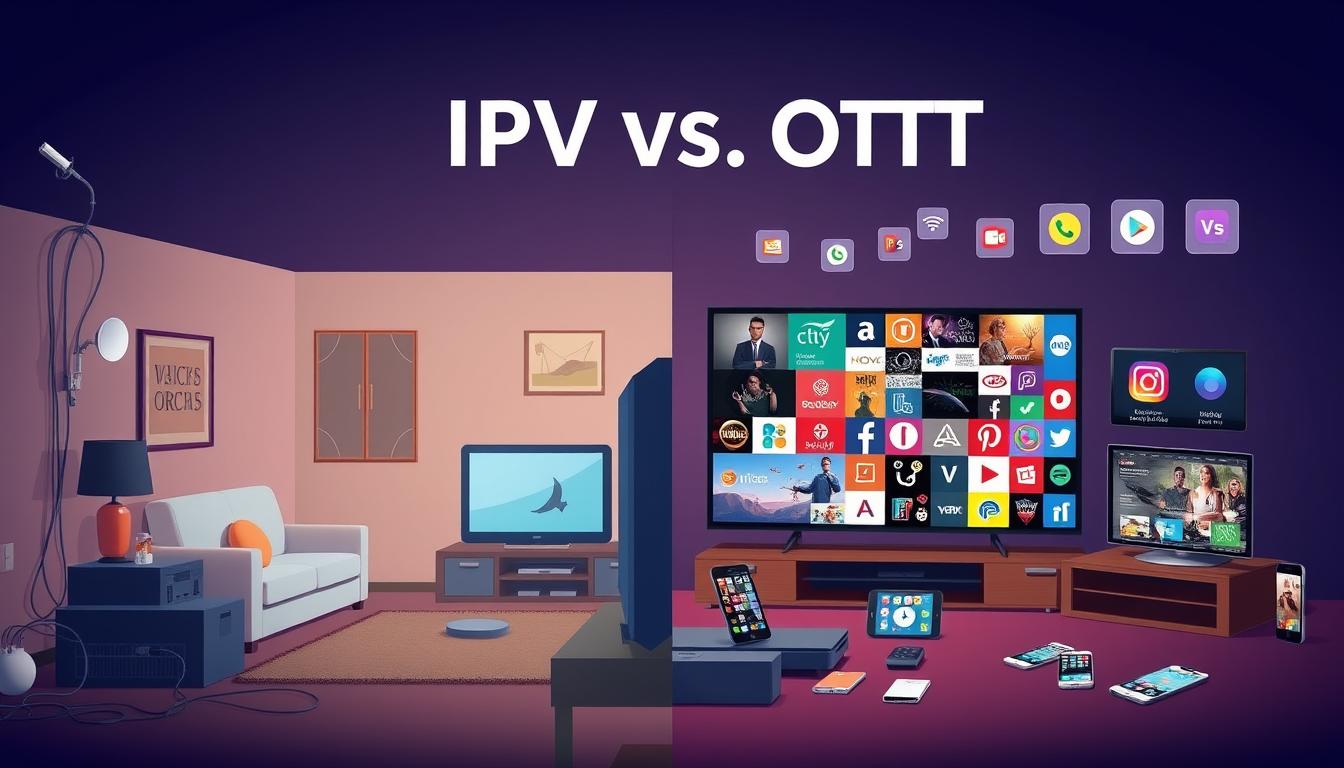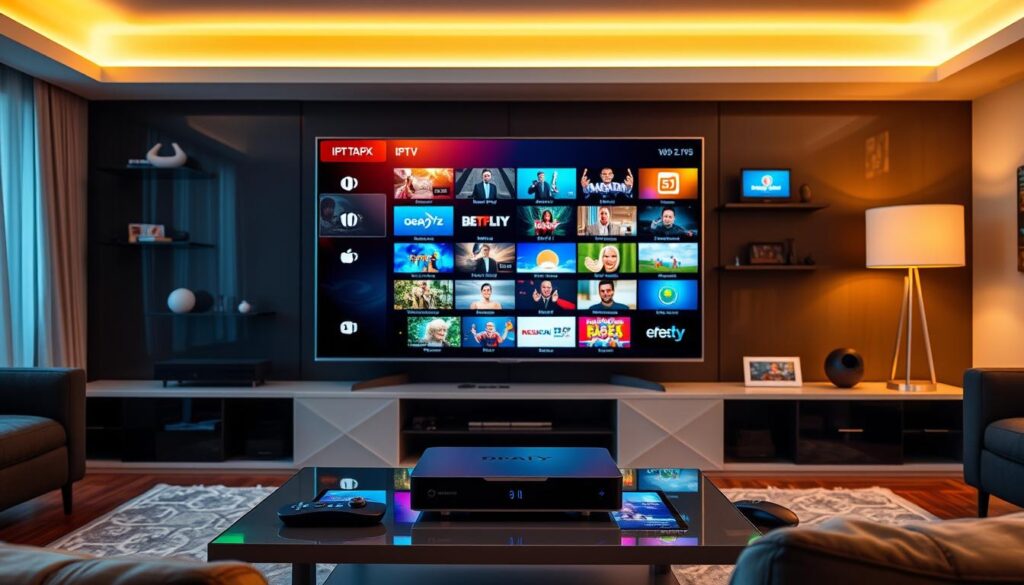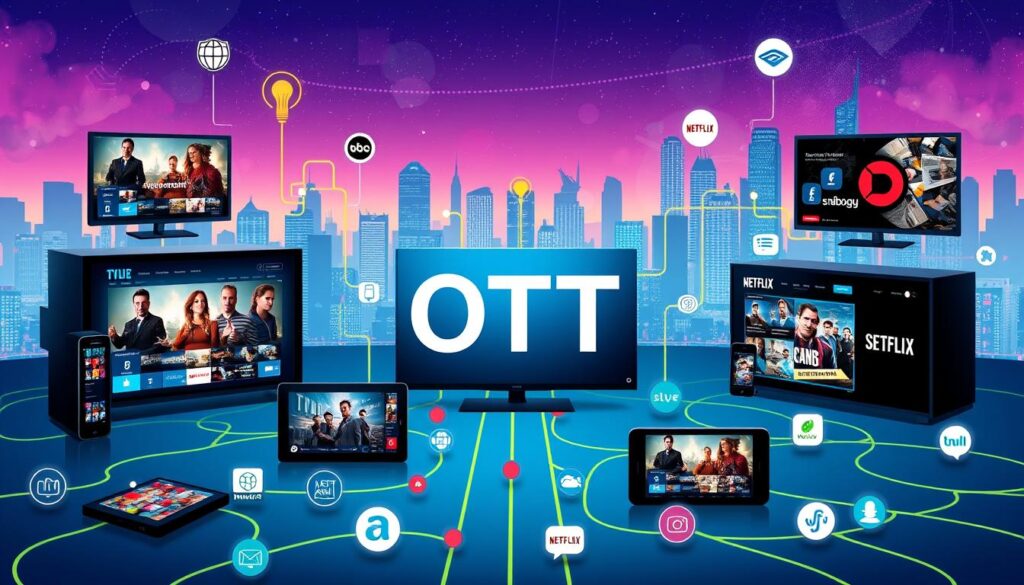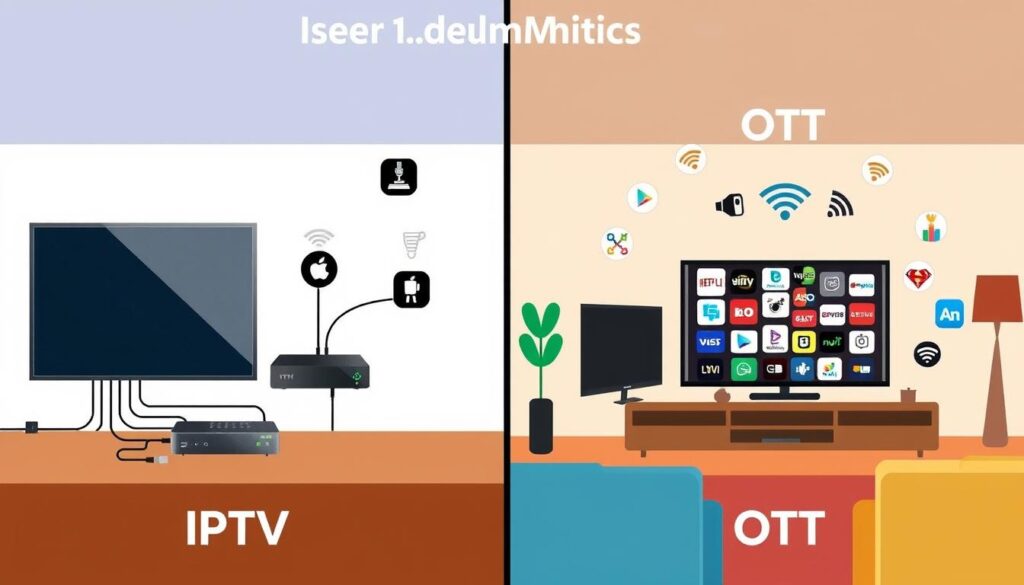
I’ve been looking into the differences between IPTV (Internet Protocol Television) and OTT (Over-The-Top) services. It’s important to know these differences if you want to choose the right subscription service. IPTV sends TV content over the internet through specific providers. OTT, on the other hand, streams media online, skipping traditional cable or satellite.
As we explore this topic, I’m excited to learn about the features and benefits of both IPTV and OTT. They both play big roles in today’s digital media world.
Key Takeaways
- IPTV is delivered through service providers, whereas OTT uses the internet directly.
- Both services cater to the growing demand for streaming services.
- Understanding their differences helps in making informed subscription choices.
- IPTV typically requires a direct subscription, while OTT can include ad-supported options.
- Quality of content and user experience can vary significantly between both services.
Introduction to IPTV and OTT
The world of entertainment has changed a lot. Now, we watch media in new ways. IPTV lets users get content from a managed network. OTT, on the other hand, sends content straight to viewers over the internet.
More people want streaming options, so IPTV and OTT are getting popular. They give us flexibility and ease. We’re moving from old cable to new internet services because we want more choices and control.
IPTV and OTT are different in many ways. IPTV is more structured, while OTT offers a wide range of content. This lets us enjoy more shows and movies without being tied to a cable.
Knowing about IPTV and OTT helps us make better choices online. OTT is easy to join, and IPTV is reliable. Together, they make watching shows and movies better than ever.
What is IPTV?
Understanding IPTV is key for those exploring new TV and media ways. You might ask, what is IPTV? This piece will cover the basics and its perks.
Definition and Overview
IPTV means Internet Protocol Television. It sends TV shows and videos over the internet, not by cable or satellite. Users can watch live or on-demand content with an IPTV service.
Devices like set-top boxes or smart TVs let users see many channels. This makes IPTV a flexible and new choice in TV.
How IPTV Works
IPTV changes video into data packets. These packets go over the internet. It lets users watch content anytime, anywhere with internet.
IPTV uses a client-server model. The user asks for content from the server. This makes data delivery smooth and viewing fun.
Advantages of IPTV
IPTV has many good points. It offers lots of channels and customizable packages. Users can pick what to watch when they want.
It also has better quality than traditional TV. Plus, catch-up TV lets users watch missed shows later. Many providers let users watch on different devices.
| Feature | IPTV | Traditional TV |
|---|---|---|
| Delivery Method | Internet Protocol | Terrestrial/Satellite/Cable |
| Content Access | On-Demand & Live | Live only, limited on-demand |
| Customization | Highly customizable packages | Fixed packages |
| Quality | Higher quality resolutions available | Varies by provider |
| Multi-Device Support | Supports multiple devices | Limited device support |
What is OTT?
OTT, or Over-The-Top, is a new way to watch media. It lets you watch shows and movies online, without cable or satellite. Netflix, Hulu, and Amazon Prime Video are examples of this change.
Definition and Overview
The OTT definition is about streaming movies, shows, and live TV online. It skips the old ways of getting TV and lets you pick what you want to watch. This shift meets the growing need for shows you can watch anytime.
How OTT Works
Learning how OTT works shows how it fits into our lives today. You sign up for these services and get access to lots of content on devices like smart TVs and phones. It uses special tech to stream content smoothly, anytime, anywhere with internet.
Advantages of OTT
The big plus of OTT advantages is the freedom to watch what you want, when you want. Some services cost money, while others are free with ads. This makes watching TV more fun than before.
“OTT services represent a new era in content consumption, empowering users with choice and convenience.”
| Feature | OTT | Traditional TV |
|---|---|---|
| Content Delivery | Internet-based streaming | Cable/Satellite |
| Subscription Models | Flexible plans | Fixed contracts |
| Content Variety | Vast and diverse | Limited channels |
| Original Programming | Yes (e.g., Netflix originals) | Rarely |
| Accessibility | Device-independent | Device-specific |
OTT’s benefits aren’t just in what you can watch. The tech behind it also makes watching more fun. For more on this, check out the latest insights on top IPTV.
What is the difference between IPTV and OTT
Knowing the IPTV vs OTT delivery methods shows their unique traits. Both deliver content, but in different ways.
Delivery Method Comparison
IPTV uses a special network from a provider. Users need a subscription and specific hardware for a steady connection. OTT, however, streams content over the internet. This means you can watch shows and movies on regular internet without special gear.
Content Ownership and Licensing
Content ownership shows the delivery differences between IPTV and OTT. IPTV gets its content through IPTV content licensing deals with broadcasters. OTT, though, owns more of its content. It creates shows and partners with others to offer unique content.
If you’re looking for a wide range of options, there are some great deals out there. Check out this source for more information.
| Feature | IPTV | OTT |
|---|---|---|
| Delivery Method | Dedicated network, subscription-based | Internet, no specialized equipment |
| Content Licensing | Agreements with broadcasters | Direct control, original content production |
| User Access | Restricted to specific hardware | Accessible on various devices |
User Experience: IPTV vs OTT
Choosing between IPTV and OTT platforms depends a lot on user experience. The interface plays a big role in how easy it is to find and watch content. IPTV feels like traditional cable TV, which is familiar but sometimes outdated.
OTT, on the other hand, offers a modern and easy-to-use design. This makes finding content a breeze, even for new users.
Interface and Usability
OTT platforms focus on creating user-friendly designs. Their simple layouts make it easy to get started. This is great for both new and experienced users.
IPTV, while familiar, might lack some of the advanced features OTT offers. This could be a drawback for those who want more from their service.
Accessibility and Availability
Being able to access content is key. IPTV can be limited by region or provider, which is frustrating. Sometimes, I can’t use IPTV outside my home network.
OTT, however, lets me stream content anywhere with internet. This flexibility is a big plus for me, making OTT more appealing.
| Feature | IPTV | OTT |
|---|---|---|
| User Interface | Traditional cable-like | Modern, intuitive |
| Usability | May require acclimation | Easy navigation |
| Accessibility | Regional restrictions | Global access with internet |
| Content Discovery | Limited options | Personalized recommendations |
Cost Comparison Between IPTV and OTT
When looking at streaming services, knowing the costs is key. IPTV and OTT have different pricing models. This affects my budget. Let’s dive into these models and any hidden costs.
Subscription Models
IPTV offers several subscription types:
- Monthly subscriptions
- Annual packages
- Tiered pricing for extra features
These options fit various viewing habits. OTT services, however, have simpler plans. They usually have a flat monthly fee for all content. This makes it easier to predict costs.
Hidden Costs and Fees
Both IPTV and OTT can have hidden costs. IPTV might include:
- Equipment rental fees
- Installation charges
- Extra costs for premium content
IPTV hidden costs can add up fast. This can make a good deal more expensive. OTT services might have hidden costs too, like:
- Subscriptions for extra content or channels
- Pay-per-view events that increase fees
It’s smart to check out specific service offers. This includes those on various IPTV platforms.
Content Variety and Quality
Entertainment needs variety and quality. Live streaming IPTV is all about live TV, perfect for sports and news. On-demand OTT lets me watch shows anytime. Knowing the differences helps us choose better.
Live Streaming vs On-Demand
Live streaming IPTV is for those who love watching TV live. It’s great for sports and news. On-demand OTT, however, lets me binge-watch shows anytime. It’s perfect for catching up or trying new things.
Content Catalog Comparison
IPTV content variety is mostly about channel packages. OTT services have a huge OTT content catalog. They offer everything from old movies to new originals. This means I can choose between live TV or a wide range of shows.
| Feature | Live Streaming IPTV | On-Demand OTT |
|---|---|---|
| Viewing Experience | Real-time broadcasts | Flexible, watch anytime |
| Content Offering | Limited channel selections | Extensive content catalog |
| Original Programming | Limited availability | Often exclusive |
| Device Compatibility | Set-top boxes, Smart TVs | Smartphones, Tablets, Smart TVs |
Exploring both shows us what’s best for our viewing habits. Whether it’s live TV or on-demand, there’s always something good to watch.
Device Compatibility
It’s key to know the devices that work with IPTV. You can use set-top boxes like Roku and Amazon Fire TV. Also, smart TVs from Samsung and LG, and computers are good choices.
These devices make sure you can stream content smoothly. This means you get high-quality pictures and sound.
Devices that Support IPTV
Set-top boxes are great for IPTV because they offer top-notch picture and sound. Smart TVs often have apps for IPTV services, making it easy to set up. Using your computer lets you access more IPTV streams.
This way, you can watch your favorite shows on a bigger screen.
Devices that Support OTT
OTT services work with many devices. You can use smartphones, tablets, and streaming sticks like Chromecast. Even gaming consoles like PlayStation and Xbox work.
This wide range of OTT compatibility means you can watch anywhere. Whether you’re at home or traveling, you can enjoy your content. For more on IPTV, check out this resource.


